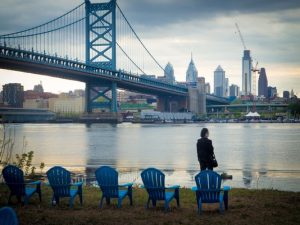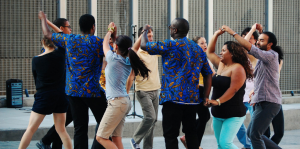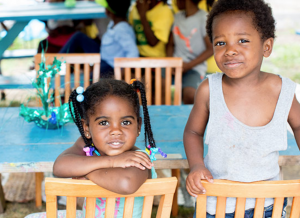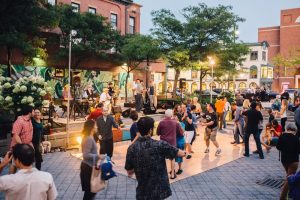“Creative Placemaking refers to the use of art and cultural projects as organizing perspectives through which the restoration and reanimation of communities can be planned and implemented. Above all, a creative place engages people in ways that lead to the social and economic re-positioning of a community.”
Nowak , Jeremy. “What Is Creative Placemaking?” J Nowak Strategy, J Nowak Strategy, 2018, www.jnowakstrategy.com/contact/.
Why is creative placemaking important in Connecticut? What is the most appropriate way to approach creative placemaking to avoid gentrification?
Hear from Kristina Newman-Scott, Connecticut’s Director of Culture:
Examples of Creative Placemaking in US Cities
Camden Nights Garden and Camden Jam, NJ
 The city of Camden, New Jersey was once considered an unsafe and poverty stricken city, but is now going through a process of revitalization and transformation due to the Camden Nights Garden project. This project was established with the help of the Connect the Lots Initiative which transforms vacant areas into positive spaces that can hold public events for the community. The initiative seeks ideas from the residents on events and programs they would like to see and they deliver it through the Camden Nights project. The goal of the project is to highlight culture, create a sense of pride and to bring people together in the space in order to bring about social vibrance. A recent example of that is The Camden Jam music festival that was held in an area called Roosevelt Plaza, held at the once vacant plaza. The festival as part of the Camden Nights Garden project left a big impact on the community and illustrates the benefits of creative placemaking. For more information (and for photo source), please click here.
The city of Camden, New Jersey was once considered an unsafe and poverty stricken city, but is now going through a process of revitalization and transformation due to the Camden Nights Garden project. This project was established with the help of the Connect the Lots Initiative which transforms vacant areas into positive spaces that can hold public events for the community. The initiative seeks ideas from the residents on events and programs they would like to see and they deliver it through the Camden Nights project. The goal of the project is to highlight culture, create a sense of pride and to bring people together in the space in order to bring about social vibrance. A recent example of that is The Camden Jam music festival that was held in an area called Roosevelt Plaza, held at the once vacant plaza. The festival as part of the Camden Nights Garden project left a big impact on the community and illustrates the benefits of creative placemaking. For more information (and for photo source), please click here.
Why is this important? What are the outcomes?
- The Camden Nights Garden Project serve as an incentive for inter and intra-city exploration while instilling pride among Camden’s residents through arts and culture and combating the effects of poverty, unemployment and violence.
Dance Place in Brookland-Edgewood, DC

Dance Place is a platform for all people to come together to learn and empower oneself and others through dance regardless of age, sex, gender, ethnicity, or religion. Dance Place creates forums for new members to work with existing residents and businesses. By creating a partnership through assigning local community development to long-term urban planning strategies, the District of Columbia Office Of Planning (DCOP) was able to make Dance Place possible. As a result of this partnership, Dance Place established rich neighborhood relationships and stands proudly on a distinguished street among other corporate businesses such as Chipotle and Barnes and Noble that make it appear no different than other busy streets among cities. The DCOP implemented the urgent need for arts and culture into planning priorities and made Dance Place available to national funders. Dance place has touched the lives of thousands of kids in assisting them to realize their talent and inner potential through education, camps, and internship programs. Dance Place is a prime example of creative placemaking by protecting and promoting cultural identity as well as the raw culture of the arts. It is not a form of gentrification because it raises the voices and inner power of those often unheard and gives its community the gift of creativity through art and performance.
For more information on Dance Place (and for photo source) please click here.
Why is this important? What are the outcomes?
- Collaborated with Temporium DC to administer public art and beautification funds, drawing on their quick, adaptive culture and their budding strength as a funding intermediary.
- Dance Place used the trust they had built in the community to play a powerful role as a mediator, broker and engagement mobilizer.
- Equipped young dancers with the tools and skills to enhance their inner potential, and provided intern + career positions for community members.
iGrow in Chicago (Englewood) , IL
iGrow Chicago creates a culture of hope to combat the affects of violence and poverty in Englewood, a south-side neighborhood of Chicago. With the help of 50 community residents, this group of individuals renovated an abandoned  house as well as three vacant lots which are now the Peace House, basketball court, and Peace Garden. Concurrently, the residents also adapted the skills of plumbing, construction, and teamwork. Since its initial development, I Grow has developed 15 different programs to equip the residents of West Englewood with the tools to stop violence before it is able to begin for the youth. It is through the power of art, meditation, mindfulness, yoga, and community gardening that iGrow combats the systematic issues of the Englewood community to spark change. While it is indeed vital to equip the young minds of children with positivity, it is also essential to take care of the parents. I Grow’s “Survive to Thrive” program is tailored to address the interconnected challenges of the neighborhood ranging from financial obstacles, skills training, legal aid, support, housing, and transportation (igrowchicago.com). I Grow has supplied bus passes, uniforms, resume and job application help, interview practice, and stipends for GED and college program
house as well as three vacant lots which are now the Peace House, basketball court, and Peace Garden. Concurrently, the residents also adapted the skills of plumbing, construction, and teamwork. Since its initial development, I Grow has developed 15 different programs to equip the residents of West Englewood with the tools to stop violence before it is able to begin for the youth. It is through the power of art, meditation, mindfulness, yoga, and community gardening that iGrow combats the systematic issues of the Englewood community to spark change. While it is indeed vital to equip the young minds of children with positivity, it is also essential to take care of the parents. I Grow’s “Survive to Thrive” program is tailored to address the interconnected challenges of the neighborhood ranging from financial obstacles, skills training, legal aid, support, housing, and transportation (igrowchicago.com). I Grow has supplied bus passes, uniforms, resume and job application help, interview practice, and stipends for GED and college program

I Grow understands that poverty is like an individual that can no longer walk without legs, and works to assist the marginalized step-by-step-in restructuring the framework of the mind, body, and spirit. Residents of the community are employed to be the role models leading programs that promote the seeds that plant empowerment through the following techniques and results:

For more information on iGrow Chicago (and for photo sources) please click here.
Why is this important? What are the outcomes?
- 26 bus cards given a week and 432 hours of job mentorship in 2017
- 24,500 community meals served
- 25 police-community healing events; 10 people trained in restorative justice
- 3,000 children taught yoga and mindfulness
- 1,000 hugs given per week
Congress Square Park in Portland, Maine

In the 80s and 90s, Congress Square Park was a thriving public space with a variety of community events. However, the park began to falter due to lack of funds and management. When the town of Portland, Maine threatened to sell the land to a developer in 2014, the community created the Friends of Congress Square Park organization to save the land as a public space. The organization began doing grassroots research into what type of amenities and uses the community wanted to see in the park. With minimal funding, the organization implemented free, public WIFI, benches, chairs and tables. Soon, food trucks and other vendors began selling their goods to pedestrians enjoying the space. Today, the thriving space is home to a variety of community events revolving around the arts.
For more information on Congress Square Park (and for photo source) please click here.
Why is this important? What are the outcomes?
- The park has seen increased engagement over the years with more people visiting, and more individuals participating in festivals, concerts and more in the park.
